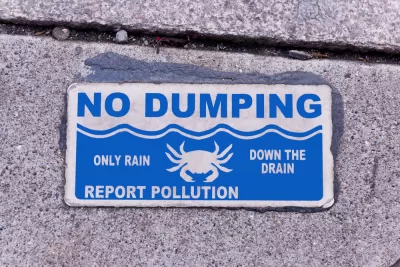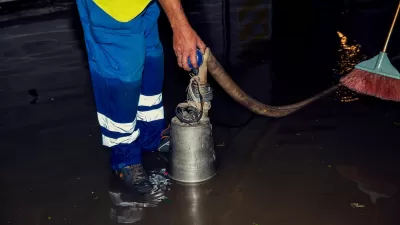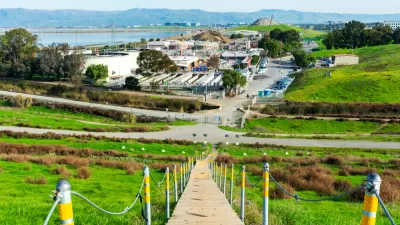The city of San Jose and designers from the University of California, Davis have completed a community-led design process to raise awareness about the connections between the kitchen, sewers, and the environment.

Faith Kearns reports on a new method for informing the public about the effects of FOG waste (the fats, oils, and greases that people can flush down sinks and toilets that lead to troubles in the sewer and beyond).
Public art might be one of the last things people associate with sewer and wastewater infrastructure, but that's the approach chosen by Claire Napawan, a landscape architect and urban designer in the Department of Human Ecology at UC Davis, and Brett Snyder, an architect and graphic designer in the Department of Design at UC Davis.
The duo worked with the city of San Jose, "as part of a unique collaboration between the city's environmental service and transportation departments, as well as its Public Art Program." Kearns details the approach to the ideas and approach behind the community engagement process before revealing the product of the project: a "suite of materials that connected household kitchen waste with sewer infrastructure."
The materials included flashcards that provide reminders of the kinds of kitchen waste that contribute to the FOG problem, marked manhole covers on city streets, and related graphics on wastewater trucks. Together, the trio of bright green and integrated graphics served as a reminder of the connection between individual kitchens, city infrastructure, and the larger ecosystem of the San Francisco Bay Area.
The hope is that the lessons gained in the community engagement process, as well as the final design product, could provide an example for other municipalities.
FULL STORY: Making the invisible visible: Connecting home water use & city infrastructure through participatory design

Planetizen Federal Action Tracker
A weekly monitor of how Trump’s orders and actions are impacting planners and planning in America.

Maui's Vacation Rental Debate Turns Ugly
Verbal attacks, misinformation campaigns and fistfights plague a high-stakes debate to convert thousands of vacation rentals into long-term housing.

San Francisco Suspends Traffic Calming Amidst Record Deaths
Citing “a challenging fiscal landscape,” the city will cease the program on the heels of 42 traffic deaths, including 24 pedestrians.

Defunct Pittsburgh Power Plant to Become Residential Tower
A decommissioned steam heat plant will be redeveloped into almost 100 affordable housing units.

Trump Prompts Restructuring of Transportation Research Board in “Unprecedented Overreach”
The TRB has eliminated more than half of its committees including those focused on climate, equity, and cities.

Amtrak Rolls Out New Orleans to Alabama “Mardi Gras” Train
The new service will operate morning and evening departures between Mobile and New Orleans.
Urban Design for Planners 1: Software Tools
This six-course series explores essential urban design concepts using open source software and equips planners with the tools they need to participate fully in the urban design process.
Planning for Universal Design
Learn the tools for implementing Universal Design in planning regulations.
Heyer Gruel & Associates PA
JM Goldson LLC
Custer County Colorado
City of Camden Redevelopment Agency
City of Astoria
Transportation Research & Education Center (TREC) at Portland State University
Jefferson Parish Government
Camden Redevelopment Agency
City of Claremont





























